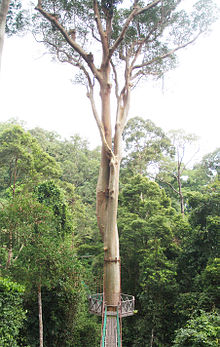
Antidesma is a genus of tropical plant in the family Phyllanthaceae formally described by Linnaeus in 1753. It is native to tropical Africa, S + E + SE Asia, Australia, and various oceanic islands. The greatest diversity occurs in Southeast Asia.

Kayea is a plant genus in the family Calophyllaceae. Its species range from Bangladesh and the eastern Himalayas to Sri Lanka, Indochina, Peninsular Malaysia, Borneo, Sumatra, the Philippines, New Guinea, and Queensland.
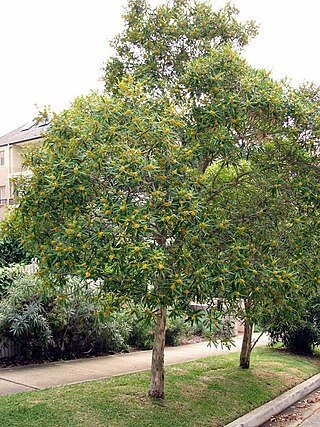
Tristaniopsis is a group of shrub and tree in the myrtle family Myrtaceae described as a genus in 1863. They have a wide distribution in Southeast Asia, New Guinea, New Caledonia and Australia.

Phoebe is a genus of evergreen trees and shrubs belonging to the Laurel family, Lauraceae. There are 75 accepted species in the genus, distributed in tropical and subtropical Asia and New Guinea. 35 species occur in China, of which 27 are endemic. The first description of the genus was of the type species P. lanceolata made in 1836 by Christian Gottfried Daniel Nees von Esenbeck in Systema Laurinarum, p. 98.

Hanguana is a genus of flowering plants with a dozen known species. It is the only genus in the family Hanguanaceae.

Daphniphyllum is the sole genus in the flowering plant family Daphniphyllaceae and was described as a genus in 1826. The genus includes evergreen shrubs and trees mainly native to east and southeast Asia, but also found in the Indian Subcontinent and New Guinea.

Actinodaphne is an Asian genus of flowering plants in the laurel family (Lauraceae). It contains approximately 125 species of dioecious evergreen trees and shrubs.

Koompassia excelsa is an emergent tropical rainforest tree species in the family Fabaceae. It is found in Indonesia, Malaysia, the Philippines, and Thailand. It is one of the tallest tropical tree species: the tallest measured specimen is 85.8 m or 88 m(281 or 289 ft) tall.
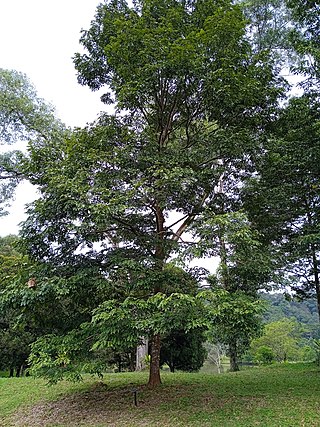
Koompassia malaccensis is a tropical rainforest tree species up to 60 m tall in the bean family (Fabaceae) and the pea subfamily (Papillionidae). It is native to Peninsular Malaysia, Singapore, Borneo and Thailand. It is among the tallest rainforest trees in the world, with one individual reaching 264 ft 10in in height. It is threatened by habitat loss. A common name for this wood is kempas, it is used as a flooring material.
Sympetalandra is a genus of legume in the family Fabaceae. It includes five species of trees native to Malesia (Peninsular Malaysia, Sumatra, Borneo, the Lesser Sunda Islands, and the Philippines, where they grow in lowland tropical forest. It belongs subfamily Caesalpinioideae.
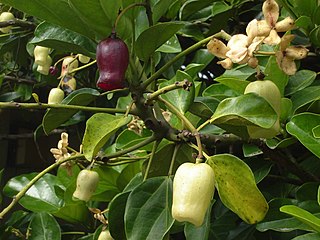
Atuna is a genus of plants in the family Chrysobalanaceae described as a genus in 1838. It is native to the Indian Subcontinent, Southeast Asia, and various islands of the western Pacific.

Beilschmiedia is a genus of trees and shrubs in family Lauraceae. Most of its species grow in tropical climates, but a few of them are native to temperate regions, and they are widespread in tropical Asia, Africa, Madagascar, Australia, New Zealand, North America, Central America, the Caribbean, and South America. The best-known species to gardeners in temperate areas are B. berteroana and B. miersii because of their frost tolerance. Seeds of B. bancroftii were used as a source of food by Australian Aborigines. Timbers of some species are very valuable.

Anisoptera is a genus of plants in the family Dipterocarpaceae. It contains ten species distributed from Chittagong in southeast of Bangladesh to New Guinea.
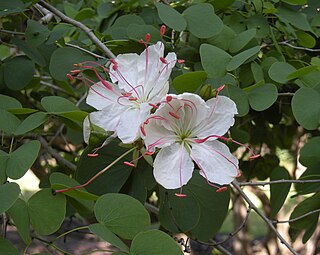
Lysiphyllum is a genus of flowering plants in the legume family, Fabaceae. It includes nine species of trees, semi-scandent shrubs, and lianas which range from India through Myanmar and Thailand to Peninsular Malaysia, Borneo, the Philippines, Java, the Lesser Sunda Islands, New Guinea, the Bismarck Archipelago, and Australia. Typical habitats include seasonally-dry tropical forest and woodland, vine thickets, Brigalow and Gidgee scrubland, floodplains, alluvial flats, tidal forest, mangroves, river and stream banks, and occasionally dunes and coral islets. They can grow on diverse soils including calcareous, granitic, and basaltic.
Cathormion is a genus of flowering plants in the family Fabaceae. It contains a single species, Cathormion umbellatum, a shrub or tree which ranges from India to Indochina, Sumatra, Java, Sulawesi, the Lesser Sunda Islands, Maluku, New Guinea, and northern Australia.
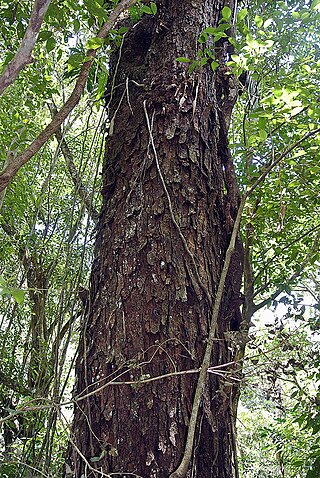
Parapiptadenia is a genus of flowering plants in the family Fabaceae. It includes six species of trees and shrubs native to eastern and southern Brazil, Bolivia, Paraguay, Uruguay, and northern Argentina. Typical habitats include tropical coastal and dune forest (restinga), woodland, scrub, and secondary growth forest. It belongs to the mimosoid clade of the subfamily Caesalpinioideae.

Phrynium is a genus of flowering plants native to China, India, Southeast Asia, New Guinea and Melanesia. It was described as a genus in 1797.
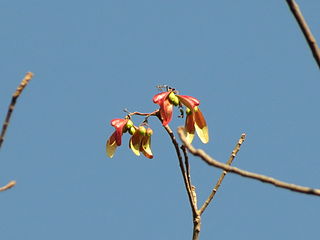
Pterocymbium is a genus in the family Malvaceae: in the subfamily Sterculioideae and previously placed in the Sterculiaceae. In Indonesia, P. tinctorium (Kelumbuk) is a significant timber tree.

The subfamily Dialioideae is one of the subdivisions of the plant family Fabaceae (legumes). This subfamily includes many tropical trees and shrubs. The subfamily consists of 17 genera, which are widespread throughout the tropics. It has the following clade-based definition:
The most inclusive crown clade containing Poeppigia proceraC.Presland Dialium guianense(Aubl.) Sandwith, but not Cercis canadensisL., Duparquetia orchidaceaBaill., or Bobgunnia fistuloides(Harms) J. H. Kirkbr. & Wiersema
Atuna excelsa is a species of flowering plant in the family Chrysobalanaceae, native to Thailand to the western Pacific.
